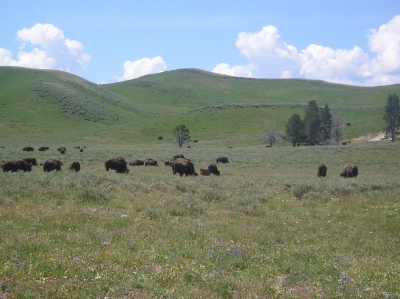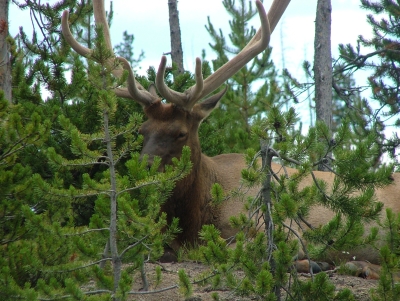Stinking springs and a lot of bisons
 Together
with Jens and Annette we began the day with breakfast at the restaurant where we
had dinner the day before, and it turned out to be excellent as well. Around
9.30 we said goodbye to Jens and Annette. They were going to Portland, Oregon,
from where they were to flying back to Wasington DC a couple of days later,
while we were going to Seattle, from where we had to fly back to Copenhagen,
also a couple of days later. Before heading north though, we would visit
Yellowstone National Park once more, taking the part of the loop, we hadn't the
previous day. Jens and Annette were a little more more busy, so they would just
drive north on U.S. 89 and then west on I-90. After saying goodbye properly, we
drove back to Mammoth Hot Springs, and here we took the eastern route through
the northern part of the loop.
Together
with Jens and Annette we began the day with breakfast at the restaurant where we
had dinner the day before, and it turned out to be excellent as well. Around
9.30 we said goodbye to Jens and Annette. They were going to Portland, Oregon,
from where they were to flying back to Wasington DC a couple of days later,
while we were going to Seattle, from where we had to fly back to Copenhagen,
also a couple of days later. Before heading north though, we would visit
Yellowstone National Park once more, taking the part of the loop, we hadn't the
previous day. Jens and Annette were a little more more busy, so they would just
drive north on U.S. 89 and then west on I-90. After saying goodbye properly, we
drove back to Mammoth Hot Springs, and here we took the eastern route through
the northern part of the loop.
The first part of the
road was through mountains, covered in forest and alpine meadows. The most
exciting experience was the winding mountain road up to Dunraven Pass at
almost 9.000 feet above sea level. There were hairpins and other turns enough to
make a dedicated Tor de France cyclist happy. From the pass the road went steeply down
toward Canyon Village, located near Yellowstone's Grand Canyon. Here we drank
coffee and ate the first and only donut on the whole trip.
When we were done drinking coffee, we continued to one of the viewing points
above Yellowstone's Grand Canyon. It was not as impressive as the "real" Grand
Canyon, but it was very nice with waterfalls and so on. From the canyon we
continued south through Hayden Valley towards the Mud Volcano area. On the way
we passed large herds and also small flocks of bison. Some fairly close to the
road, and we had to stop a couple of times to give way for small groups that
wanted to cross the road in front of us.
When we arrived in the Mud Volcanboe area, we first took a look
at Sulphur Caldron and several other sulfur-stinking mud-pools, including
Dragon's Mouth, which both looks lie a mouth and sounds like a fire-breathing
dragon - or so I think - I have never met a dragon! Near one of the pools a
big bison bull enjoyed itself and the sulfur stench. They must have a different
sense of smell than we humans. It made it difficult to comply with the
rule in the park that says that you must remain at least 25 yards from animals
in general and 100 yards from bears. The bull apparently did not know
 that
rule, as it did not stay 25 yards away from us. When we couldn't stand the smell
any more we returned to Canyon Village, passing the bisons once more. At Canyon
Village we headed west, past the Norris Geyser Basin, which we had visited the
day before. We didn't stop though, but continued west heading for the western
entrance to the park. On the way we had to stop a few times because the other
cars queued up. Both times it turned out that someone had seen elk, and so we
used the opportunity to photograph the animals, especially a large bull that was
enjoying itself on a slope above the road. It was definitely not shy, but seemed
rather as if it enjoyed the attention. Before leaving the park we saw several
elks, mule deers, a random coyote who crossed the road, a couple of bald eagle
and one osprey, but unfortunately we were not allowed to stop the car as the
eagles were nesting, so we could not take any pictures.
that
rule, as it did not stay 25 yards away from us. When we couldn't stand the smell
any more we returned to Canyon Village, passing the bisons once more. At Canyon
Village we headed west, past the Norris Geyser Basin, which we had visited the
day before. We didn't stop though, but continued west heading for the western
entrance to the park. On the way we had to stop a few times because the other
cars queued up. Both times it turned out that someone had seen elk, and so we
used the opportunity to photograph the animals, especially a large bull that was
enjoying itself on a slope above the road. It was definitely not shy, but seemed
rather as if it enjoyed the attention. Before leaving the park we saw several
elks, mule deers, a random coyote who crossed the road, a couple of bald eagle
and one osprey, but unfortunately we were not allowed to stop the car as the
eagles were nesting, so we could not take any pictures.
There are many animals in the park, including around 3,000 bison, which is the
largest group in the United States. In addition, the park is also one of the few
places in the United States, where you can meet both grizzly bears and black
bears. However, we saw none of them on that occation, neither did we came across
moose, gray wolves or mountain lions (cougars). All these animals are very shy,
and disappear if possible if people come close. Also bighorn sheep and
pronghorns did we miss, and probably also a number of smaller animals, but if
you must see them, you have to get up, so you can be at water holes already
around sunrise, and it none of us wanted to do that on this trip.
Immediately outside the west entrance is the town of West Yellowstone, and here
we filled our car with petrol and fueled ourselves with a hot dog each. It was
already 2.30 pm, and there were still around 100 miles to the interstate, and as
we would like to get closer to the Idaho border we only made a short stop before
moving on. From West Yellowstone we took U.S. 289 to the northwest. The
road leads through Gravely Range, and as we entered the mountains it began to
rain, and there was some strong, but rather shortlived thunder showers, not least
as we drove along Hebgen Lake, which is a fairly large artificial lake. When we
left West Yellowstone the temperature was 93, but in ten minutes it fell to 53
when we were hit by the showers. From the lake's north end the road follows Madison
River through a wide valley with Gravely Range on one side and Madison Range on
the other. Along the next 40 miles or so, we passed several cattle ranches, and
the animals we saw most of, were cows. Most of these ranches also announced on
roadside signs that they offered fly fishing, and at one place we were even
offered fly fishing instruction. At the north end of the valley U.S. 289 left
the river and returned to the mountains. Also here we passed ranches and pparently horses were the preferred animal in these parts. We reached the
interstate and sped west. When we reached Missoula around 7.30 pm, we agreed to
call it a day and find a hotel for the night.